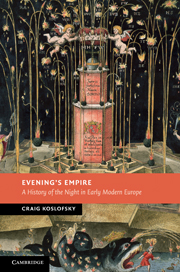Book contents
- Frontmatter
- Contents
- Figures
- Maps
- Acknowledgments
- Chapter One An early modern revolution
- Chapter Two Darkness and the Devil, 1450–1650
- Chapter Three Seeking the Lord in the night, 1530–1650
- Chapter Four Princes of darkness: the night at court, 1600–1750
- Chapter Five “An entirely new contrivance”: the rise of street lighting, 1660–1700
- Chapter Six Colonizing the urban night: resistance, gender, and the public sphere
- Chapter Seven Colonizing the rural night?
- Chapter Eight Darkness and Enlightenment
- Chapter Nine Conclusion
- Notes
- Bibliography
- Index
Chapter Six - Colonizing the urban night: resistance, gender, and the public sphere
Published online by Cambridge University Press: 05 August 2013
- Frontmatter
- Contents
- Figures
- Maps
- Acknowledgments
- Chapter One An early modern revolution
- Chapter Two Darkness and the Devil, 1450–1650
- Chapter Three Seeking the Lord in the night, 1530–1650
- Chapter Four Princes of darkness: the night at court, 1600–1750
- Chapter Five “An entirely new contrivance”: the rise of street lighting, 1660–1700
- Chapter Six Colonizing the urban night: resistance, gender, and the public sphere
- Chapter Seven Colonizing the rural night?
- Chapter Eight Darkness and Enlightenment
- Chapter Nine Conclusion
- Notes
- Bibliography
- Index
Summary
By 1700 life at court meant late hours, and permanent public street lighting was reshaping everyday life in dozens of cities across Northern Europe. Dutch city councilors, London merchants, and the police administrators of the Sun King all sought to expand respectable daily activity into the night in the second half of the seventeenth century. This unique alignment of interests across political and economic formations attests to the powerful forces behind nocturnalization. Sovereigns and self-governing cities celebrated at night and established street lighting with the same stated goals: to reflect their own glory and to protect their subjects.
Regular public street lighting, together with an improved and expanded night-watch, was the infrastructure of urban nocturnalization. It was also the most visible and expensive aspect of the project. According to its heralds, the lighting responded to “the great number of vagabonds and thieves at night … and the amount of robberies and murders that are committed in the evening and at night” (Paris), and marked a concerted effort to “detect burglaries and prevent foul play” (Amsterdam), “for the reduction and prevention of all the recently increasing nocturnal and frightening murder and theft, and for the introduction of general security” (Vienna). One London enthusiast singled out the social groups that would be driven away by the lighting:
The scatt’ring Light gilt all the Gaudy way,
Some people rose and thought it day.
The plying Punks crept into Holes,
Who walk’d the streets before by sholes;
The Night could now no longer skreen
The Tavern-sots from being seen.
- Type
- Chapter
- Information
- Evening's EmpireA History of the Night in Early Modern Europe, pp. 157 - 197Publisher: Cambridge University PressPrint publication year: 2011



